The Changing Network Environment (1.4)
The network environment continues to evolve, providing new experiences and opportunities for end users. The network is now capable of delivering services and applications in a manner that couldn’t be imagined years ago.
Network Trends (1.4.1)
Just as the way we work, play, and learn impacts the network, the availability of a robust reliable network has an impact on our daily lives.
New Trends (1.4.1.1)
As new technologies and end user devices come to market, businesses and consumers must continue to adjust to this ever-changing environment. The role of the network is transforming to enable the connections between people, devices, and information. There are several new networking trends that will affect organizations and consumers. Some of the top trends include
Bring Your Own Device (BYOD)
Online collaboration
Video communication
Cloud computing
Bring Your Own Device (1.4.1.2)
The concept of any device, to any content, in any manner, is a major global trend that requires significant changes to the way devices are used. This trend is known as Bring Your Own Device (BYOD).
BYOD is about end users having the freedom to use personal tools to access information and communicate across a business or campus network. With the growth of consumer devices, and the related drop in cost, employees and students can be expected to have some of the most advanced computing and networking tools for personal use. These personal tools include laptops, netbooks, tablets, smartphones, and e-readers. These can be devices purchased by the company or school, purchased by the individual, or both.
BYOD means any device, with any ownership, used anywhere. For example, in the past, a student who needed to access the campus network or the Internet had to use one of the school’s computers. These devices were typically limited and seen as tools only for work done in the classroom or in the library. Extended connectivity through mobile and remote access to the campus network gives students tremendous flexibility and more learning opportunities for the student.
Online Collaboration (1.4.1.3)
Individuals want to connect to the network, not only for access to data applications, but also to collaborate with one another. Collaboration is defined as “the act of working with another or others on a joint project.” Collaboration tools, like Cisco WebEx shown in Figure 1-29, give employees, students, teachers, customers, and partners a way to instantly connect, interact, and achieve their objectives.
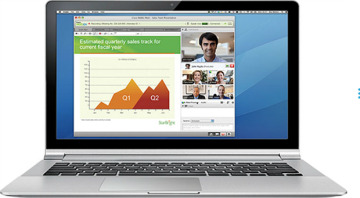
Figure 1-29 Cisco WebEx
For businesses, collaboration is a critical and strategic priority that organizations are using to remain competitive. Collaboration is also a priority in education. Students need to collaborate to assist each other in learning, to develop team skills used in the work force, and to work together on team-based projects.
Video Communication (1.4.1.4)
Another trend in networking that is critical to the communication and collaboration effort is video. Video is being used for communications, collaboration, and entertainment. Video calls can be made to and from anywhere with an Internet connection. Consider how many people are now using Skype or FaceTime to communicate with friends and family.
Video conferencing is a powerful tool for communicating with others at a distance, both locally and globally. Video is becoming a critical requirement for effective collaboration as organizations extend across geographic and cultural boundaries. Play the video to view how TelePresence can be incorporated into everyday life and business.

Go to the online course to view this video.
Cloud Computing (1.4.1.5)
Cloud computing is another global trend changing the way we access and store data. Cloud computing allows us to store personal files, even backup our entire hard disk drive on servers over the Internet. Applications such as word processing and photo editing can be accessed using the Cloud.
For businesses, Cloud computing extends IT’s capabilities without requiring investment in new infrastructure, training new personnel, or licensing new software. These services are available on demand and delivered economically to any device anywhere in the world without compromising security or function.
There are four primary types of Clouds, as shown in Figure 1-30.
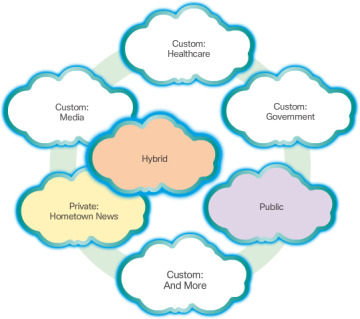
Figure 1-30 Types of Clouds
Private clouds – Cloud-based applications and services offered in a private cloud are intended for a specific organization or entity, such as the government. A private cloud can be set up using the organization’s private network, although this can be expensive to build and maintain. A private cloud can also be managed by an outside organization with strict access security.
Public clouds – Cloud-based applications and services offered in a public cloud are made available to the general population. Services may be free or are offered on a pay-per-use model, such as paying for online storage. The public cloud uses the Internet to provide services.
Hybrid clouds – A hybrid cloud is made up of two or more clouds (example: part custom, part public), where each part remains a distinctive object, but both are connected using a single architecture. Individuals on a hybrid cloud would be able to have degrees of access to various services based on user access rights.
Custom clouds – These are clouds built to meet the needs of a specific industry, such as healthcare or media. Custom clouds can be private or public.
Cloud computing is possible because of data centers. A data center is a facility used to house computer systems and associated components. A data center can occupy one room of a building, one or more floors, or an entire building. Data centers are typically very expensive to build and maintain. For this reason, only large organizations use privately built data centers to house their data and provide services to users. Smaller organizations that cannot afford to maintain their own private data center can reduce the overall cost of ownership by leasing server and storage services from a larger data center organization in the Cloud.
Networking Technologies for the Home (1.4.2)
Today’s home networks are used in every aspect of our daily lives, for entertainment, education, communications, and business.
Technology Trends in the Home (1.4.2.1)
Networking trends are not only affecting the way we communicate at work and at school, but they are also changing just about every aspect of the home, as shown in Figure 1-31.
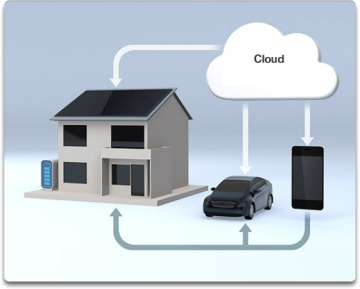
Figure 1-31 Smart Home Technology
The newest home trends include ‘smart home technology.’ Smart home technology is technology that is integrated into everyday appliances, allowing them to interconnect with other devices, making them more ‘smart’ or automated. For example, imagine being able to prepare a dish and place it in the oven for cooking prior to leaving the house for the day. Imagine if the oven was ‘aware’ of the dish it was cooking and was connected to your ‘calendar of events’ so that it could determine what time you should be available to eat, and adjust start times and length of cooking accordingly. It could even adjust cooking times and temperatures based on changes in schedule. Additionally, a smartphone or tablet connection allows the user the ability to connect to the oven directly to make any desired adjustments. When the dish is “available,” the oven sends an alert message to a specified end user device that the dish is done and warming.
This scenario is not far off in the future. In fact, smart home technology is currently being developed for all rooms within a house. Smart home technology will become more of a reality as home networking and high-speed Internet technology become more widespread. New home networking technologies are being developed daily to meet these types of growing technology needs.
Powerline Networking (1.4.2.2)
Powerline networking is an emerging trend for home networking that uses existing electrical wiring to connect devices, as shown in Figure 1-32.
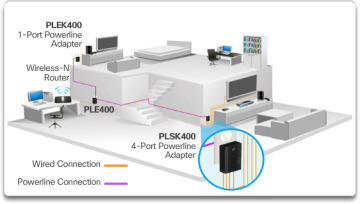
Figure 1-32 Powerline Networking
The concept of “no new wires” means the ability to connect a device to the network wherever there is an electrical outlet. This saves the cost of installing data cables and without any additional cost to the electrical bill. Using the same wiring that delivers electricity, powerline networking sends information by sending data on certain frequencies.
Using a standard powerline adapter, devices can connect to the LAN wherever there is an electrical outlet. Powerline networking is especially useful when wireless access points cannot be used or cannot reach all the devices in the home. Powerline networking is not designed to be a substitute for dedicated cabling in data networks. However, it is an alternative when data network cables or wireless communications are not a viable option.
Wireless Broadband (1.4.2.3)
Connecting to the Internet is vital in smart home technology. DSL and cable are common technologies used to connect homes and small businesses to the Internet. However, wireless may be another option in many areas.
Wireless Internet Service Provider (WISP) is an ISP that connects subscribers to a designated access point or hot spot using similar wireless technologies found in home wireless local area networks (WLANs). WISPs are more commonly found in rural environments where DSL or cable services are not available.
Although a separate transmission tower may be installed for the antenna, it is common that the antenna is attached to an existing elevated structure, such as a water tower or a radio tower. A small dish or antenna is installed on the subscriber’s roof in range of the WISP transmitter. The subscriber’s access unit is connected to the wired network inside the home. From the perspective of the home user, the setup is not much different than DSL or cable service. The main difference is that the connection from the home to the ISP is wireless instead of a physical cable.
Another wireless solution for the home and small businesses is wireless broadband, as shown in Figure 1-33.
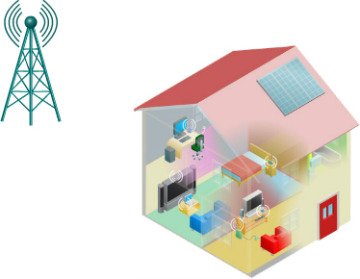
Figure 1-33 Wireless Broadband Service
This uses the same cellular technology used to access the Internet with a smart phone or tablet. An antenna is installed outside the house providing either wireless or wired connectivity for devices in the home. In many areas, home wireless broadband is competing directly with DSL and cable services.
Network Security (1.4.3)
For a network to be entrusted with the communications of personal and business information, that network must be secure.
Security Threats (1.4.3.1)
Network security is an integral part of computer networking, regardless of whether the network is limited to a home environment with a single connection to the Internet or as large as a corporation with thousands of users. The network security that is implemented must take into account the environment as well as the tools and requirements of the network. It must be able to secure data while still allowing for the quality of service that is expected of the network.
Securing a network involves protocols, technologies, devices, tools, and techniques to secure data and mitigate threats. Threat vectors may be external or internal. Many external network security threats today are spread over the Internet.
The most common external threats to networks include
Viruses, worms, and Trojan horses – malicious software and arbitrary code running on a user device
Spyware and adware – software installed on a user device that secretly collects information about the user
Zero-day attacks, also called zero-hour attacks – an attack that occurs on the first day that a vulnerability becomes known
Hacker attacks – an attack by a knowledgeable person to user devices or network resources
Denial of service attacks – attacks designed to slow or crash applications and processes on a network device
Data interception and theft – an attack to capture private information from an organization’s network
Identity theft – an attack to steal the login credentials of a user in order to access private data
It is equally important to consider internal threats. There have been many studies that show that the most common data breaches happen because of internal users of the network. This can be attributed to lost or stolen devices, accidental misuse by employees, and in the business environment, even malicious employees. With the evolving BYOD strategies, corporate data is much more vulnerable. Therefore, when developing a security policy, it is important to address both external and internal security threats.
Security Solutions (1.4.3.2)
No single solution can protect the network from the variety of threats that exist, both internal and external, as shown in Figure 1-34.
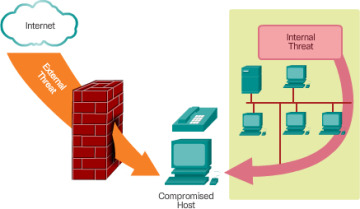
Figure 1-34 Threats to Networks
For this reason, security should be implemented in multiple layers, using more than one security solution. If one security component fails to identify and protect the network, others still stand.
A home network security implementation is usually rather basic. It is generally implemented on the connecting end devices as well as at the point of connection to the Internet and can even rely on contracted services from the ISP.
In contrast, the network security implementation for a corporate network usually consists of many components built into the network to monitor and filter traffic. Ideally, all components work together, which minimizes maintenance and improves security.
Network security components for a home or small office network should include, at a minimum
Antivirus and antispyware – These are used to protect end devices from becoming infected with malicious software.
Firewall filtering – This is used to block unauthorized access to the network. This may include a host-based firewall system that is implemented to prevent unauthorized access to the end device or a basic filtering service on the home router to prevent unauthorized access from the outside world into the network.
In addition to the above, larger networks and corporate networks often have other security requirements:
Dedicated firewall systems – These are used to provide more advanced firewall capabilities that can filter large amounts of traffic with more granularity.
Access control lists (ACL) – These are used to further filter access and traffic forwarding.
Intrusion prevention systems (IPS) – These are used to identify fast-spreading threats, such as zero-day or zero-hour attacks.
Virtual private networks (VPN) – These are used to provide secure access to remote workers.
Network security requirements must take into account the network environment, as well as the various applications, and computing requirements. Both home environments and businesses must be able to secure their data while still allowing for the quality of service that is expected of each technology. Additionally, the security solution implemented must be adaptable to the growing and changing trends of the network.
The study of network security threats and mitigation techniques starts with a clear understanding of the underlying switching and routing infrastructure used to organize network services.

Activity 1.4.3.3: Network Security Terminology
Go to the online course to perform this practice activity.
Network Architecture (1.4.4)
[The role of the network has changed from a data-only network to a system that enables the connections of people, devices, and information in a media-rich, converged network environment. In order for networks to function efficiently and grow in this type of environment, the network must be built upon a standard network architecture.
Cisco Network Architecture (1.4.4.1)
The network architecture refers to the devices, connections, and products that are integrated to support the necessary technologies and applications. A well-planned network technology architecture helps ensure the connection of any device across any combination of networks. While ensuring connectivity, it also increases cost efficiency by integrating network security and management and improves business processes. At the foundation of all network architectures, and, in fact, at the foundation of the Internet itself, are routers and switches. Routers and switches transport data, voice, and video communications, as well as allow for wireless access, and provide for security.
Building networks that support our needs of today and the needs and trends of the future starts with a clear understanding of the underlying switching and routing infrastructure. After a basic routing and switching network infrastructure is built, individuals, small businesses, and organizations can grow their network over time, adding features and functionality in an integrated solution.
CCNA (1.4.4.2)
As the use of these integrated, expanding networks increases, so does the need for training for individuals who implement and manage network solutions. This training must begin with the routing and switching foundation. Achieving Cisco Certified Network Associate (CCNA) certification is the first step in helping an individual prepare for a career in networking. Other certifications beyond the Associate are also available, as shown in Figure 1-35.
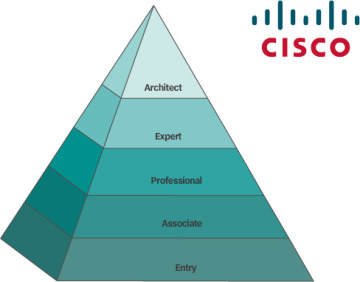
Figure 1-35 Cisco Certification Hierarchy
CCNA certification validates an individual’s ability to install, configure, operate, and troubleshoot medium-size routed and switched networks, including implementation and verification of connections to remote sites in a WAN. CCNA curriculum also includes basic mitigation of security threats, introduction to wireless networking concepts and terminology, and performance-based skills. This CCNA curriculum includes the use of various protocols, such as Ethernet, VLANs, IPv4, IPv6, Open Shortest Path First (OSPF), Enhanced Interior Gateway Routing Protocol (EIGRP), access control lists (ACLs) and others.
This course helps set the stage for networking concepts and basic routing and switching configurations and is a start on your path toward CCNA certification.
 Lab 1.4.4.3: Researching IT and Networking Job Opportunities
Lab 1.4.4.3: Researching IT and Networking Job Opportunities